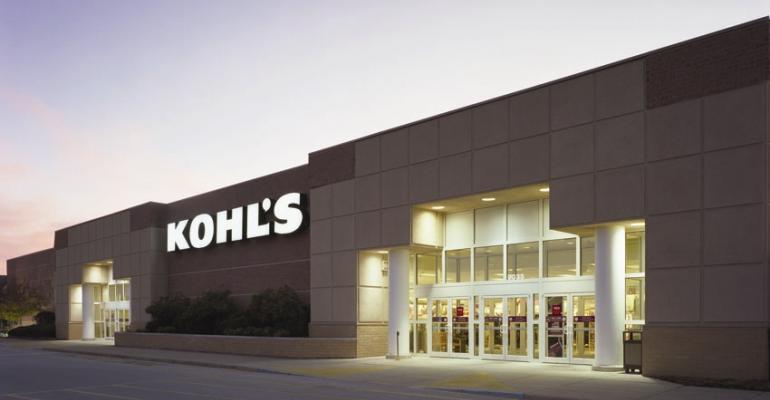Department store chain Kohl’s is aggressively pursuing new distribution channels, including smaller format stores, outlet stores and the expansion of Off-Aisle, its pilot concept that is stocked exclusively with returned merchandise. Kohl’s Chairman, President and CEO Kevin Mansell detailed the retailer’s plans during its recent earnings call.
The initiatives are part of a larger strategic plan that Kohl’s calls the Greatness Agenda, which kicked-off last year after several months of internal discussion, Mansell explained during the WWD Apparel & Retail CEO Summit last month. Kohl’s launched the Greatness Agenda in an effort to reinvigorate the company, which caters to middle market, middle income consumers.
In the last few years, Kohl’s growth has flattened both in terms of sales and market share. In the three quarters before the Greatness Agenda was launched last year, sales and traffic at Kohl’s stores were down about 2 percent. Mansell attributes some of the decrease to consumers having less discretionary income. Beyond that, consumers are spending less on categories where Kohl’s holds a large share of the pie—apparel, for example.
Perhaps more important, however, is the change in consumer mindset regarding pricing and the rapid growth of off-price retailers. “It created a whole new set of consumer expectations that were very different than the consumer expectations that existed in the past,” Mansell said. “Consumers moved from a simple proposition in our case of visiting stores that were easy to shop to a dynamic environment where low prices and off-price was a much bigger factor—and virtual options existed in addition to the brick-and-mortar options.”
Accessing smaller markets
Since launching the Greatness Agenda, Kohl’s has produced four consecutive quarters of positive comps. By the end of 2017, the chain wants to achieve $21 billion in sales, and its bricks-and-mortar presence will play a significant role.
“We became $19 billion by creating an easier experience in a physical place, in a brick-and-mortar store,” Mansell pointed out during the WWD Apparel & Retail CEO Summit.“Our brick-and-mortar business and our physical presence is a dramatic competitive advantage versus both virtual retailers and some of our brick-and-mortar competition.”
Currently, Kohl’s has almost 1,200 stores nationwide. Looking forward, Kohl’s is focused on rolling out smaller format stores. The new 35,000-sq.-ft. prototype will provide access to a great number of smaller markets, as well as create fill-in opportunities in urban areas that don’t have the economics or the availability of real estate to support a larger store, according to Mansell.
“It’s going to be a challenge for us because our core box is around 90,000 square feet,” Mansell said. “We have to take the concepts and the experience from 90,000 square feet and figure out how to make it all happen, with the aid of technology in some cases, in 35,000 square feet.”
The 35,000-sq.-ft. prototype stores are meant tocomplement Kohl’s existing large-scale format. However, the chain may downsize some stores that have not met volume expectations.
In Boston, for example, Kohl’s has downsized two stores, giving space back to the landlords, according to Wesley S. McDonald, CFO, senior executive vice president and head of investor relations.He says the downsizing strategy would likely be limited to the Northeast and Mid-Atlantic, where real estate is at a premium, and the chain occupies older Bradlees and Caldor boxes that are 100,000 to 120,000 sq. ft.
“I don’t know necessarily that we see fewer stores,” Mansell said. “They’ll probably look a little different and they’ll probably be smaller than they are now, but I actually think this strategy, effectively executed, will give us more presence, not less presence than we have today.”
Appealing to bargain hunters
In addition to smaller format stores, Kohl’s is entering the outlet business and expanding its pilot program for its off-price concept, Off-Aisle.
The chain intends to launch an outlet model beginning next year with some of its proprietary brands. The first brand will be FILA, and Kohl’s plans to open 10 to 15 stores in the spring of next year.
Finally, Kohl’s plans to test two more pilots of its Off-Aisle concept. Currently, it operates one Off-Aisle store in Cherry Hill, N.J. The store is stocked exclusively by returned merchandise.
Industry experts say Off-Aisle helps Kohl’s kill two birds with one store. First, it addresses consumers’ increasing desire to hunt for bargains and the increased competition from other off-price concepts ranging from Nordstrom Rack to TJ Maxx. Second, it solves the problem of returns, which plague every retailer. More than $200 billion worth of merchandise is returned every year, according to the National Retail Federation, and most of it cannot be returned to the “store floor.”
“I think this is an idea worth exploring, especially in today’s retail environment, as more and more major brands introduce off price concepts and outlets,” says Catherine Timko, principal/CEO of The Riddle Company, a Washington, D.C.-based marketing firm focused on economic development and retail. “This is an interesting way for Kohl’s to differentiate themselves from other stores at their price point and capitalize on a market that traditionally has cost retailers money. It might prove very appealing to bargain hunters.”
Timko says the concept has potential if Kohl’s can introduce a reliable selling environment where consumers can confidently buy name products that are in perfect condition for less.
Kohl’s traditional format is popular with retail owners and landlords not only because of the chain’s strong credit, but also because of the type of customer it attracts and the traffic it generates. Timko says Off-Aisle could end up being just as attractive, depending on how Kohl’s positions the stores.
“If it creates an attractive selling environment with quality merchandising it could be appealing to landlords with large vacant spaces,” she says. “There are plenty of markets with discount brands adjacent to premium ones. I think the real risk to landlords is the unknown of whether the concept is sustainable.”

